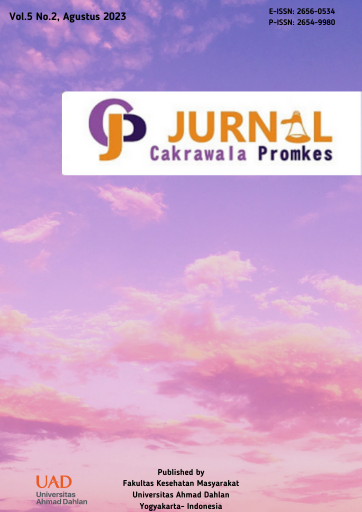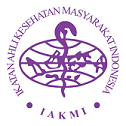Factors Associated with Work Fatigue among Nurses in South Tangerang City Public Hospital
DOI:
https://doi.org/10.12928/promkes.v5i2.8846Keywords:
Factors Impacting Fatigue, Nurse Well-Being, Nursing Care Quality, Patient Safety, Work FatigueAbstract
Work fatigue is a pervasive issue that affects nursing care quality and patient safety in healthcare settings. This study examined the prevalence of work fatigue among nurses and its association with various factors, including age, body mass index (BMI), work tenure, and work shift. This study employed a cross-sectional quantitative approach and was conducted at the South Tangerang City Public Hospital from February to March 2023. A total of 85 nurses participated in this study. The Industrial Fatigue Research Committee (IFRC) instrument was used to measure work fatigue, encompassing general, mental, and physical domains. Workload-related symptoms were assessed using Likert scale-based responses, classifying the respondents into fatigue and non-fatigue groups. The results indicated that 55.3% of the nurses reported experiencing work fatigue. Significant associations were observed between work fatigue and several other factors. Older nurses demonstrated a lower prevalence of work fatigue (PR:0.579; 95% CI: 0.415–0.808), suggesting that age is a protective factor against fatigue. Conversely, nurses with non-normal BMI exhibited a higher prevalence of work fatigue (PR: 1.587; 95% CI: 1.100–2.291). A longer work tenure was associated with increased work fatigue (PR: 1.851, 95% CI: 1.298–2.639), possibly due to cumulative stress and physical demands. Furthermore, night-shift nurses experienced higher work fatigue (PR: 1.882, 95% CI: 1.302–2.721) than day-shift nurses, indicating the disruptive impact of irregular sleep patterns. These findings emphasize the need for healthcare organizations to address work fatigue among nurses. Strategies may include workload management, providing resources for emotional support, and promoting a healthy work environment. Addressing the specific vulnerabilities of younger nurses, individuals with non-normal BMI, and working night shifts is vital for mitigating work fatigue
References
Cho H, Sagherian K, Scott LD, Steege LM. Occupational fatigue, workload and nursing teamwork in hospital nurses. J Adv Nurs. 2022 Aug;78[8]:2313–26.
Geiger-Brown J, Rogers VE, Trinkoff AM, Kane RL, Bausell RB, Scharf SM. Sleep, Sleepiness, Fatigue, and Performance of 12-Hour-Shift Nurses. Chronobiol Int. 2012 Mar;29[2]:211–9.
Sunjaya DK, Herawati DMD, Siregar AYM. Depressive, anxiety, and burnout symptoms on health care personnel at a month after COVID-19 outbreak in Indonesia. BMC Public Health. 2021 Jan 28;21[1]:227.
Taskiran Eskici G, Uysal Kasap E, Gumus E. Relationships between leadership behaviour of nurse managers and nurses’ levels of job satisfaction and compassion fatigue during the COVID-19 pandemic. Nurs Open. 2023 Mar 6;nop2.1701.
Dall’Ora C, Ball J, Reinius M, Griffiths P. Burnout in nursing: a theoretical review. Hum Resour Health. 2020 Dec;18[1]:41.
Budiono B, Budi Pertami S. Konsep dasar keperawatan. 1st ed. Jakarta: Bumi Medika; 2015.
Pongantung M, Kapantouw NH, Kawatu PAT. The Association Between Workload and Job Stress with Job Fatigue in Hospital Nurses Gmim Kalooran Amurang Hospital. J Kesehat Masy Univ Sam Ratulangi. 2018;7[5].
Suma’mur S. Corporate Hygiene and Occupational Health. 2nd ed. Jakarta: Sagung Seto; 2014.
Gumelar H, Kusmiran E, Haryanto MS. The Association of Workload with Work Fatigue in Executive Nurses in Inpatient Installations. J Persat Perawat Nas Indones JPPNI. 2021 Sep 24;6[2]:89.
Rahmawati R, Afandi S. Factors Associated with Work Fatigue in Nurses at Bangkinang Hospital in 2019. PREPOTIF J Kesehat Masy. 2019;3.
Barker LM, Nussbaum MA. Fatigue, performance and the work environment: a survey of registered nurses: Fatigue, performance and the work environment. J Adv Nurs. 2011 Jun;67[6]:1370–82.
Abdul Rahman H, Abdul-Mumin K, Naing L. Psychosocial factors, musculoskeletal disorders and work-related fatigue amongst nurses in Brunei: structural equation model approach. Int Emerg Nurs. 2017 Sep;34:17–22.
Ihsan T, Edwin T, Azwir Y, Derosya V. Fatigue analysis to evaluate workloads in production area at crumb rubber factories of Padang city, West Sumatra Indonesia. Indian J Occup Environ Med. 2020;24[3]:148.
Ramdan, Iwan Muhamad. Measuring Work Fatigue on Nurses: A Comparison between Indonesian Version of Fatigue Assessment Scale [Fas] and Japanese Industrial Fatigue Ressearch Commite [Jifrc] Fatigue Questionnaire. J Keperawatan Padjadjaran. 2019 Aug;7[2]:141–51.
Shultz KS, Wang M, Crimmins EM, Fisher GG. Age Differences in the Demand—Control Model of Work Stress: An Examination of Data From 15 European Countries. J Appl Gerontol. 2010 Feb;29[1]:21–47.
Scheibe S, Yeung DY, Doerwald F. Age-related differences in levels and dynamics of workplace affect. Psychol Aging. 2019 Feb;34[1]:106–23.
Purcell SR, Kutash M, Cobb S. The relationship between nurses’ stress and nurse staffing factors in a hospital setting: Nurse stress. J Nurs Manag. 2011 Sep;19[6]:714–20.
Hariharan R, Odjidja EN, Scott D, Shivappa N, Hébert JR, Hodge A, et al. The dietary inflammatory index, obesity, type 2 diabetes, and cardiovascular risk factors and diseases. Obes Rev [Internet]. 2022 Jan [cited 2023 May 5];23[1]. Available from: https://onlinelibrary.wiley.com/doi/10.1111/obr.13349
Mendoza-Muñoz M, Adsuar JC, Pérez-Gómez J, Muñoz-Bermejo L, Garcia-Gordillo MÁ, Carlos-Vivas J. Influence of Body Composition on Physical Fitness in Adolescents. Medicina [Mex]. 2020 Jul 2;56[7]:328.
Kumar P, Rai D, Kanwar M. Comparison of clinical and polysomnographic parameters between obese and nonobese obstructive sleep apnea. J Fam Med Prim Care. 2020;9[8]:4170.
Keller E, Hittle BM, Smith CR. Tiredness Takes Its Toll: An Integrative Review on Sleep and Occupational Outcomes for Long-Term Care Workers. J Gerontol Nurs. 2023 Jan;49[1]:27–33.
Chalder T, Neeleman J, Reme SE, Power M, Wessely S. Factors associated with acute fatigue in primary care. Psychol Med. 2010 Aug;40[8]:1289–95.
Meacham H, Tham TL, Holland P, Bartram T, Halvorsen B. The role of high-involvement work practices, supervisor support and employee resilience in supporting the emotional labour of front-line nurses. Int J Hum Resour Manag. 2023 Feb 21;34[4]:745–67.
Peters V, Houkes I, De Rijk AE, Bohle PL, Engels JA, Nijhuis FJN. Which resources moderate the effects of demanding work schedules on nurses working in residential elder care? A longitudinal study. Int J Nurs Stud. 2016 Jun;58:31–46.
Ortega-Campos E, Vargas-Román K, Velando-Soriano A, Suleiman-Martos N, Cañadas-de La Fuente GA, Albendín-García L, et al. Compassion Fatigue, Compassion Satisfaction, and Burnout in Oncology Nurses: A Systematic Review and Meta-Analysis. Sustainability. 2019 Dec 20;12[1]:72.
Bathen T, Velvin G, Rand-Hendriksen S, Robinson HS. Fatigue in adults with Marfan syndrome, occurrence and associations to pain and other factors. Am J Med Genet A. 2014 Aug;164[8]:1931–9.
Park JH, Park H, Bae S, Kang J. Associations between the Timing and Nutritional Characteristics of Bedtime Meals and Sleep Quality for Nurses after a Rotating Night Shift: A Cross-Sectional Analysis. Int J Environ Res Public Health. 2023 Jan 13;20[2]:1489.
Membrive-Jiménez MJ, Gómez-Urquiza JL, Suleiman-Martos N, Velando-Soriano A, Ariza T, De La Fuente-Solana EI, et al. Relation between Burnout and Sleep Problems in Nurses: A Systematic Review with Meta-Analysis. Healthcare. 2022 May 21;10[5]:954.
Daouda OS, Bun RS, Ait Bouziad K, Miliani K, Essa-Eworo A, Espinasse F, et al. Multilevel approach to individual and organisational predictors of stress and fatigue among healthcare workers of a university hospital: a longitudinal study. Occup Environ Med. 2022 Dec;79[12]:839–47.
Downloads
Published
Issue
Section
License
Copyright (c) 2023 Haris Muzakir, Andra Vidyarini

This work is licensed under a Creative Commons Attribution-ShareAlike 4.0 International License.
Authors who publish with JCP: Jurnal Cakrawala Promkes agree to the following terms:
- Authors retain copyright and grant the journal the right of first publication with the work simultaneously licensed under a Creative Commons Attribution License (CC BY-SA 4.0) that allows others to share the work with an acknowledgement of the work's authorship and initial publication in this journal.
- Authors are able to enter into separate, additional contractual arrangements for the non-exclusive distribution of the journal's published version of the work (e.g., post it to an institutional repository or publish it in a book), with an acknowledgement of its initial publication in this journal.
- Authors are permitted and encouraged to post their work online (e.g., in institutional repositories or on their website) prior to and during the submission process, as it can lead to productive exchanges, as well as earlier and greater citation of published work.

This work is licensed under a Creative Commons Attribution-ShareAlike 4.0 International License












